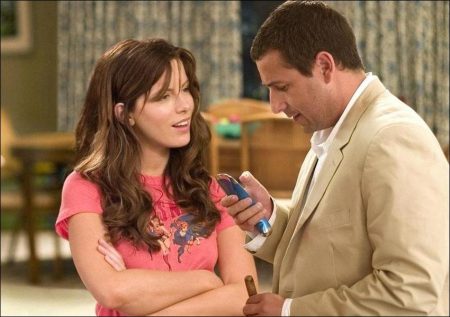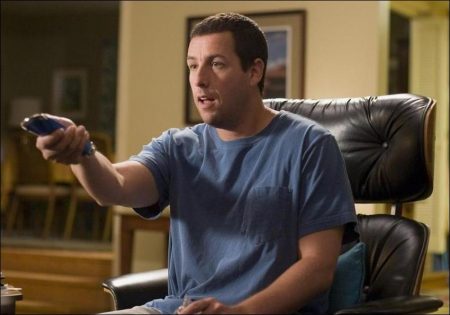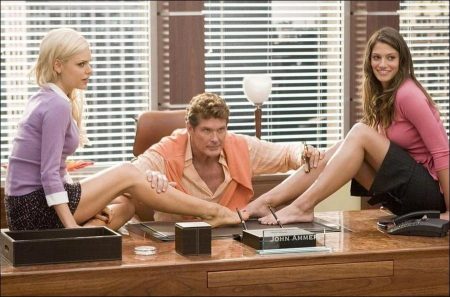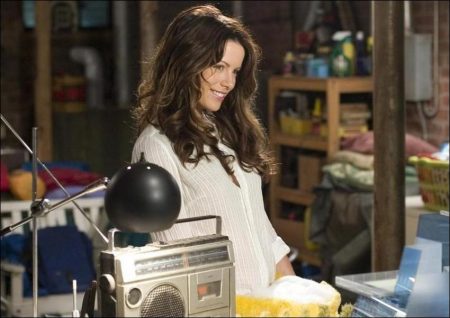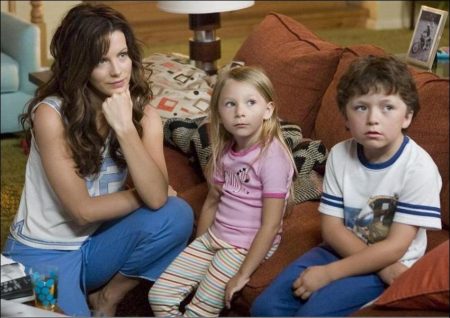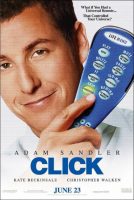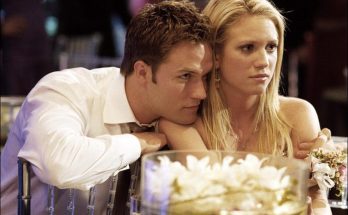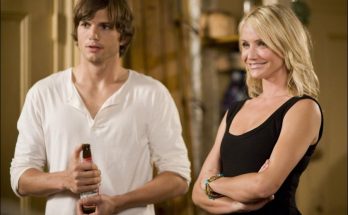Tagline: What if you had a universal remote… That controlled your universe?
Michael Newman (Adam Sandler) is married to the beautiful Donna (Kate Beckinsale) and they have two terrific kids, Ben (Joseph Castanon) and Samantha (Tatum McCann). But he doesn’t get to see them much because he’s putting in long, hard hours at his architectural firm in the elusive hope that his ungrateful boss (David Hasselhoff) will one day recognize his invaluable contribution and make him a partner.
Once he’s on easy street, he’ll be able to lavish attention on the wife and kiddies. At least, that’s what he tells himself. After staying up all night to work, a tired Michael becomes frustrated because he can’t even figure out which of his remotes will turn on the TV set. Michael sets out to find the perfect device to operate all his electronic equipment and stumbles into the back room of a Bed, Bath & Beyond, where an eccentric employee, Morty (Christopher Walken), gives him an experimental one-of-a-kind souped-up gadget guaranteed to change his life.
Morty wasn’t kidding either. Soon Michael is master of his domain, turning on every appliance with the click of a button. But the device has other, more startling functions. It can somehow muffle the barking of Sundance, the family dog – and even more astoundingly, fast forward through an annoying quarrel with his wife.
Michael is fascinated by his new toy and a little freaked out as well. He decides to pay another visit to Morty, the guy who sold him the mysterious device. Morty tells Michael he gave him exactly what he asked for – a universal remote that lets him control his universe. Right before Michael’s astonished eyes, Morty demonstrates the device’s mind-boggling advanced features, including a function that lets Michael travel back and forth through his life at different speeds.
Michael quickly becomes addicted to this new rush of power, which literally allows him to have his cake and eat it too.
But before he knows it, the remote is programming him, rather than the other way around. And try as he might, a panicked Michael can’t stop the device from deciding which events of his life he’ll experience and which ones he’ll miss. Only then does he begin to truly appreciate and embrace his life – the good, the bad and the ugly.
Click is a 2006 American science fiction comedy-drama film directed by Frank Coraci, written by Steve Koren and Mark O’Keefe, and produced by Adam Sandler, who also starred in the lead role. The film co-stars Kate Beckinsale as his wife Donna and Christopher Walken as Morty. Sandler plays an overworked architect who neglects his family. When he acquires a universal remote that enables him to “fast forward” through unpleasant or outright dull parts of his life, he soon learns that those seemingly bad moments that he skips over contained valuable time with his family and important life lessons. Throughout the story, a man named Morty explains how the remote works and issues warnings.
Filming began in late 2005 and was finished by early 2006. The film was released in the United States on June 23, 2006, by Columbia Pictures. It was nominated for an Academy Award for Best Makeup, making this the only Sandler film to be nominated for an Oscar.
About the Production
Screenwriter and producer Steve Koren recalls how he and his partner Mark O’Keefe came up with the idea for CLICK. “There was a joke between me and my girlfriend,” Koren recalls. “We got into a long argument, so I picked up the remote, pointed it at her and hit the `mute’ button. She didn’t find my little wish amusing, but I thought a lot of people could relate.”
They started with a simple idea: “What if you could actually control your life with the remote? What if you could raise the volume of the world or lower it?” From there the story progressed. What if you could rewind your life and look back at your past? What if, instead of worrying about the future, you could fast forward and look at it? “There were many different areas for the character to explore and it was fun having him jump around while trying to maintain a consistent emotional arc,” Koren continues. “In addition to exploring the past and future to find what he wants, he learns other things about his life along the way.”
The easy part, says Koren, was sitting around with his writing partner O’Keefe and coming up with every joke they could think of about the use of a remote. “The tougher part,” he contends, “was the emotional journey. It’s not like most films, where you start one day and you end a week later. You’re constantly jumping around. The movie starts in the present, then goes to the past, then leaps ahead 30 years into the future and then drops way back to when the character is child. Writing-wise it was tough to construct.”
Adding to the degree of difficulty was the fact that, at first, many of the time jumps Michael makes are intentional. “At work, he wants this promotion without having to sit around and experience the day-to-day drudgery of getting there,” Koren laughs. “With a simple press of the button, he’s suddenly a partner. Who wouldn’t be tempted to hit that button?
However, problems arise when the remote starts to anticipate his intentions and makes jumps all on its own. For instance, every time he starts to argue with his wife, the remote jumps until the fight is over. “The movie presents a combination of those choices. At first, Michael knows where he’s going, but soon he has no idea what’s going to happen next. He just keeps waking up and suddenly it’s 30 years later and he’s in bed with someone he doesn’t know,” says Koren. “The autopilot aspect of the story came about to underline the more serious themes of the movie. You can be at an event, but not really present. You’re either thinking about something that happened in your past or worried about getting somewhere else later. We decided to give it a name – you’re on autopilot, talking to people, but not really there.”
Koren’s favorite segment of Click is when Michael first gets the remote and he hits the menu on his life. “I just love the fantasy of that happening to you. Somebody gives you a DVD and says, `Here’s your life,’ and you pop it into the player and hear a running commentary on the making of you. That was really fun to write and even more fun to watch Frank direct and Adam act it. It’s a real joke bag, literally one joke after another, after another.”
Koren’s relationship with Sandler dates back to “Saturday Night Live” where they worked on many sketches together. “Comedians like Adam are good at thinking on their feet, so they’re always coming up with new jokes,” explains Koren. “Adam and Frank have collaborated on a lot of big hits. He loves to hear ideas and he usually takes them and comes up with something even better. It’s fun to throw stuff at him and he runs with it so that every take is different.”
The Family Click
Director Frank Coraci says that what drew him to Click was the chance to work with his buddies on such an exciting project. “I knew that I would be looking forward to how much fun I was going to have at work every single day,” he says. “As I sat there reading the script, I kept dreaming up these amazing transitions through time going from one room to the next or fast forwarding out of a situation.”
As he envisioned it, the premise of Click would enable him to be more visually adventurous than is usually the case with comedies. “For a director, it allows you to dream up these great visual moments, to storyboard them and then come to the set every day and execute them,” he enthuses. “It’s a really cool journey.”
Coraci and the film’s star and producer, Adam Sandler, have been friends since they were teenagers. They went to college together (Click producer Jack Giarraputo was Coraci’s roommate) and have always had the ability to make each other laugh. “Another reason Click is so much fun is that it’s filled with the kind of stuff that makes me and Adam laugh – stuff about life we learned when we were growing up. As we’re getting older, we’re starting to make movies about things that we’ve experienced in life.”
The on-the-set camaraderie and the trusting relationships formed back in college days paid off creatively as well. “During production, at the end of every day, we’d kind of high five each other or regroup and say, `Boy this script is funny, but the stuff we came up with on the set today was even funnier,'” says Coraci. “It was so cool, because Adam is so good at that. He makes it all look so easy.”
Though Oscar winner Christopher Walken was new to the group, he immediately fit right in, according to Coraci. “When you see Adam and Christopher Walken side by side it’s pretty cool. Walken is a genius actor, but the pairing of him and Adam together is even more amazing. It’s rare you get to see two such great talents get together and do funny stuff like that.”
Walken also brought his training as a singer and dancer to bear in the role of Morty, the enigmatic behind-the-scenes store clerk. “Walken does a little dancing and some singing in the movie,” says Coraci. “But what was most impressive is that he can pick any word of his dialogue from the script and make it funny. Listen to the way he says the word `remote’ with such a dry delivery that’s just hilarious. I don’t know of any actor who can say one word like that and be funny.”
For “the perfect wife,” Coraci says, they found the perfect actress – Kate Beckinsale. “The key thing in the movie is that Adam’s character has two amazing kids and a wife who is supportive and gorgeous. She’s the kind of perfect woman than anybody would want to be married to, strong and beautiful with a good heart. I don’t know of anyone who’s not going to fall in love with her in this movie.”
To play Sandler’s parents, Ted and Trudy, the filmmakers turned to two comic veteran actors, Henry Winkler and Julie Kavner. “They are the perfect blue-collar, sweet parents who get on your nerves because they love you so much. Henry and Julie did it so well. As soon as we put them together, we realized we couldn’t have come up with a better combination. They both have the ultimate comedy chops. Henry, who worked with us before on The Waterboy, completely understood our routine. And, Julie, what can I say? She got into the rhythm very quickly and when you have all these people that are comfortable with each other, things can get really funny.”
David Hasselhoff plays Mr. Ammer, Michael’s insensitive boss. Coraci describes him as an actor “who has so much energy you’d think there were seven of him instead of only one. Besides being an icon, the guy is really funny. And when he arrived he just came in, put his total trust in us and had a great time.”
The production was no less lucky with the actors who took on the roles of Sandler and Beckinsale’s children. “They were amazing,” says Coraci. “Tatum McCann, (Samantha) is a sweetheart, you warm to her immediately. Joseph Castanon (Ben) is just this really talented little boy. He can do it all. Don’t tell anyone, but despite what they say about working with child actors, they were the easiest people to direct. They learned so fast and did everything I said exactly right.”
Besides their talent, McCann and Castanon connected emotionally with Coraci as well. “They were the most loving kids. At the end of the day they would come up to me and say `Frank, we love you,’ and give me a big hug. It was perfect for the movie because it created a real sense of family.”
Behind the Scenes
“Perry Andelin Blake, my production designer, has done all my movies, including The Wedding Singer, The Waterboy and Around the World in 80 Days,” says Coraci. “He was the one who said to me, `Frank, you’ve got to do this movie because we’re going to get to create these amazing worlds. We get to do the ultimate bachelor pad in the future.'”
Click not only gave Blake a chance to travel into the future, but also, via flashbacks, to the past. “From the start, Frank and I conceived the design of Michael’s house, which is a very important set because a great deal of the movie is set there, and Michael is, by profession, an architect,” says Blake. “He bought this `50s house that was decorated in a `70s style with plans to eventually redo it and have this really cool house. But, because Michael is a workaholic, he never gets around to it. It’s his wife who clears it out and redoes it.”
In creating where Michael will live in the future, Blake conceived “this crazy apartment that’s really cold – black with grays and blues. Since Michael changes as his life goes along, we wanted to create a strong contrast between it and his old life, a regular family life in which all the colors are warm and inviting- tactile materials like stone and wood in very earthy tones. Then you see Michael’s apartment and it’s slick, shiny and hard, very unnatural, angular, pointy and sharp.”
The “Beyond” section of the Bed, Bath & Beyond store that Michael visits, which is where Morty resides, was designed to be “eccentric,” says Blake, “like the character of Morty. It had to have this weird eerie feeling, like the whole world back there in `Beyond’ is kind of strange. So we mixed old and new, objects that looked very modern, beside things that were very old. In a Bed Bath & Beyond store, you’re used to seeing bath items, beds, linens and comforters. Then you see this door with the sign `Beyond Time’ glowing at you and there’s a transition. When you open that door and enter, you definitely get the sense you’re going to another place. It has this super-long hallway from which Michael sees Morty grinding on this key, though he doesn’t know what it is. But there are sparks and it’s very mysterious. When he meets him, Morty is singing a song and he’s wearing these weird glasses that were designed to flip up so you can see his very strange eyes.”
One of the essential elements of Blake’s design was the universal remote that propels the story forward. “We figured we would make it simple instead of high-tech,” he says, “because basically it’s a remote for dummies, for the average guy. When I designed it, I wanted it to be comfortable to hold, not like so many remotes. I took a piece of clay and squished my fingers into it and then molded in where I thought the buttons should be. I wanted it to be super ergonomic, to feel good in your hand with a good weight to it and a very organic feel.”
Futuristic Cars
“All the cars used in Click are by General Motors,” according to Blake. “We have the minivan of the future, which belongs to Bill, Donna’s future husband. It’s more than just a car you can pack six people into. We built the van so that the doors move up and slide out. It’s even more comfortable to sit in than a living room because it’s oversized with big Tonka truck-like tires. The way we saw it, the future will be more organic, more smooth and curvy as opposed to sharp and hard.”
Blake worked closely with special effects supervisor John Hartigan in deciding how to cut up the new cars that were going to be made into futuristic autos. “We took a brand new minivan and made it look like a dune buggy in 72 hours,” Hartigan explains. “We went through the car with plasma cutters and saws and completely cut it up. We used the cases, the frames and motors to totally re-fabricate it into a car of the future.”
Another car, an ambulance, turned out looking like a fish, a carp or a catfish. “We conceived of it without headlights, just an opening in the front that looks like a mouth with lights that blaze out onto the highway,” says Blake. “Instead of having a light bar on top of the ambulance, the whole back end just sort of glows and pulses with this blue light. You definitely see it coming down the road.”
Michael’s car in the film was a 2016 Cadillac called a Cadillac 12. The 12-cylinder auto is an actual Cadillac concept car (that GM says will never actually be sold) that can run on 12 cylinders or, when you get on the highway, goes down to four cylinders.
The 2016 period cars in the film are angular and conform with the sharp angles of Michael’s house. As the film moves farther into the future, everything gets softer, Blake explains. The softness in the car designs mirror the curves in Michael’s office and the lobby of his architectural firm. “I wanted to make sure that you related to Michael’s life throughout the movie and that even though he moves into the future and there were some crazy elements in the sets, it always remained somehow grounded in reality, so you didn’t lose your attachment to Michael and his emotional journey.”
Visual Effects
Overseeing the task of supervising the visual effects in Click were Academy Award winner Jim Rygiel and Pete Travers from Imageworks. “What we did in this movie entailed what are called hidden effects,” explains Rygiel. “Basically, what happens is that there are a couple shots in which Adam’s character rewinds to his younger self, so there you have the younger Michael and the older Michael at the same time and I have to figure out how to get the two of them to look at each other and react to one another.”
The way the illusion was achieved, Rygiel continues, was through the use of computer-controlled cameras “that repeated the same move many times. We would shoot Michael as his older self and then the younger Michael. Then we would combine them and you see them reacting to one another.”
Rygiel worked closely with a number of different departments throughout the film. He constantly coordinated with the animal trainers and special effects departments to achieve the shots Coraci was after. “Visual effects has a lot to do with the look of the film and how the effects are going to appear visually on the screen, whereas special effects is more practical, like when rain is needed over a whole set. Special effects hang the giant rain buckets and rain hoses. They do all the explosions, either live or via green screen. They’re more hands-on, while visual effects is achieved more by shooting bits and pieces, collecting them and taking them back to Sony Pictures Imageworks and putting them all together over a period of three or four months in post-production. When the editors get their cut list, they give that to us and we decide how it’s all going to be put together.”
Real-time film compositing is fairly old technology in today’s visual effects world, Rygiel contends. “Today we have the new Genesis digital camera. With film, things can get messy and unwieldy because you have to scan and color correct. With the new Genesis camera, it goes right into our system. Before, it would take us two to three days to get a piece of film into our system. Now I literally can walk from the set and have it on our system in an hour. It saves a lot of time. The quality is fantastic for blue screens, there’s no film grain any more. That side of technology is really exciting.”
For Rygiel and his crew, creating a futuristic look was a delicate balancing act, “because we were constantly having to weigh the pros and cons of how far we can go. Just because something is possible, doesn’t necessarily mean it’s right.” Rygiel worked closely with the art department on when to use a TransLite (which are basically large photographs that are backlit), since TransLites can look quite static. So when he does use a TransLite, Rygiel is careful to add life-like elements to the backdrop – smoke coming out of chimneys, birds flying, an airplane off in the distance – visual cues to distract the audience from the fact that they are staring at a static image.
Special Effects
Special effects supervisor John Hartigan claims that although there are many challenges for his department when working on a Happy Madison project, it is always a great deal of fun. In one scene, a toy helicopter has to fly at Sandler’s character and hit him in the head. Hartigan had to figure out how to make that happen. “We decided to make the helicopter out of a very soft foam and then find a way to fly it toward Adam and smack him in the head. The best way to do that was to use a wire, so we could control the motion of the helicopter. It turned out to be a pretty funny visual gag.”
The special effects department used big cranes and big one-hundred-foot rain bars for a location shot outside a hospital set in Thousand Oaks. Hartigan and his crew brought in a couple of 300-ton cranes in order to rain across the entire expanse of the location. Another challenging scene for Hartigan was turning an entire city block in Glendale into an East Coast winter wonderland. Working all night and through the morning, Hartigan and his crew flocked all the trees and snow-blanketed the streets and rooftops and added icicles to the eaves. About 100 tons of real crushed ice were mashed and turned into real snow, some of it plowed into snow banks. “You have these 300-pound blocks of ice, 40-foot trailers and five tons of ice blocks and we use big blowers to shoot the snow 40 or 50 feet into the air. When it falls to the ground, we shoveled it and made it look like it was the product of a recent storm.”
For another scene, Hartigan and his special effects crew wired the character of Morty (Christopher Walken) in a “harness gag,” which is to magically transport him to the beyond. “We used the harness gag again when we get into green screen. We built a rig to travel along the floor and go up and down with Christopher and composited scenes in the background. We wanted Morty to look like he was floating and what he’s wearing was flowing. So we had to shoot him in green screen so that his clothes looked like they were floating down the street and chasing Michael (Sandler’s character).”
Special make-up effects designer Rick Baker was taking some time off to be with his kids when executive producer Barry Bernardi (with whom he’d worked on Haunted Mansion) called and asked him to read the script Click. “The script really touched me,” says Baker. “It was very much about appreciating the people around you while you have them.”
Taking on Click was a real challenge for Baker, because “The hardest kind of make-up to pull off is realistic old age. Those are the kinds of things that fail most often. It’s much easier to do an alien or some kind of monster because you don’t see that everyday. But you do see old people and the movie covers the whole course of a person’s life.”
Sandler’s character must age from 17 to old age, and his parents (Henry Winkler and Julie Kavner) also move from young, middle age, to senior citizens. “We do this with a number of the characters who you see at different times and different ages. Fortunately, I have a great group of truly talented people I work with who’ve had a lot of experience doing these kind of movies on people who have to age,” says Baker.
The first step in the process was to collect photographs of all the characters he was working on. “We then take a life cast, from which we make a sculpture. We get video of them in motion and how their faces move and fold,” says Baker. “From where the folds are, we try to predict where the future sags and wrinkles are going to be when they age. We then make PhotoShop designs of what we think they should look like and give the actors several choices.”
“With a great beauty like Beckinsale,” Baker continues, “Even at her oldest, she is still beautiful. The change is subtle. But there’s definitely something there and she does look older.”
“One of the biggest challenges was Henry Winkler and Julie Kavner, who had to look older and younger at different times,” says Baker. “You see them when Adam’s character is born and we had to make them look like young parents again. So we took two different casts of them, one a normal life cast and one with lifts, for which we taped them up, almost like a surgical facelift.”
“The process was very uncomfortable for the actors because their skin was pulled tight around the neck and face,” he continues. “We actually glued the skin under their eyes to just under the eyelash line. Then we carefully made them up and they had wigs and hairpieces and such. I was pretty impressed with what we achieved. They definitely looked a heck of a lot younger. It was pretty dramatic. It’s too bad that Henry’s old and young scenes aren’t right next to each other. It’s a pretty amazing change.”
“You definitely need the actor’s cooperation to do these kinds of make-up changes,” Baker continues. “It’s very tough to sit someone in a chair for that long. I’ve had other people make me up and I know the time is so different when you’re the person in the chair as opposed to the person doing the make-up. If we were doing a fake head and paint, we spend a week on it. Here you have an hour at the most in the chair to accomplish a week’s worth of painting. And gluing all the pieces on, especially the silicone, is very tough. It’s supple, like a piece of liver and in positioning it you can actually stretch it out of shape if you’re not careful. It’s also very hard if you get the edges screwed up because you basically have to start all over again.”
Baker sat down with Sandler and explained what his life progression would look like. Sandler confessed that he can be a fidget in a make-up chair if he has to sit for too long and Baker told him that he needed him to be still. “He told me that it was going to be hard for him,” Baker laughs. “But I told him it was only a few days, not like The Grinch or Nutty Professor, where the actors were in make-up every day for three months. Fortunately, I have some great make-up artists. Bill Corso applied Adam’s make-up. The person who is very responsible for the looks of Click is somebody that works for me that I sponsored from Japan, Kazuhiro (Kazu) Tsuji. Kazu is the future of make-up. He has the same kind of love for it that I do, and I think that’s why our work is so good. It’s not just a job for us. We really love what we do. And Kazu is an amazing talent. He was very involved in the designing and manufacturing of the pieces as well as applying the make-up. Kazu applied Henry’s make-up and David Hasselhoff’s make-up and did all the initial tests,” explains Baker.
Sandler’s fat make-up was a great big silicone piece with no seams on it. Baker made a head cast of the actor and then broke it down like a puzzle into multiple pieces. It took six weeks to make the cast, an amazing epoxy puzzle of Sandler’s face that was made into a mold with no seams so it could be applied and look completely believable.
“In the film, Adam’s character wakes up one day and sees himself in the mirror and screams because he now weighs over 300 pounds,” says Baker. “On the days when these scenes were shot, it took approximately four or five hours to complete the process of applying his silicone face pieces, make-up and hair and getting him into his fat suit. Ultimately Adam’s character became a 300-pound man in a jogging suit with “Extra Juicy” on his butt. It wasn’t easy for Adam to sit through the process, but he was ultimately glad he did it. The payoff was fantastic.”
Click (2006)
Directed by: Frank Coraci
Starring: Adam Sandler, Christopher Walken, Kate Beckinsale, Blake Heron, Allen Covert, Peter Dante, David Hasselhoff, Sean Astin, Rachel Dratch, Katie Cassidy, Tatum McCann
Screenplay by: Mark O’Keefe, Steve Wayne Koren, Tim Herlihy
Production Design by: Perry Andelin Blake
Cinematography by: Dean Semler
Film Editing by: Jeff Gourson
Costume Design by: Ellen Lutter
Set Decoration by: Gary Fettis
Art Direction by: Alan Au, Jeffrey Mossa
Music by: Rupert Gregson-Williams
MPAA Rating: PG-13 for language, crude and sex related humor, drug references.
Distributed by: Columbia Pictures
Release Date: June 23, 2006
Visits: 68
